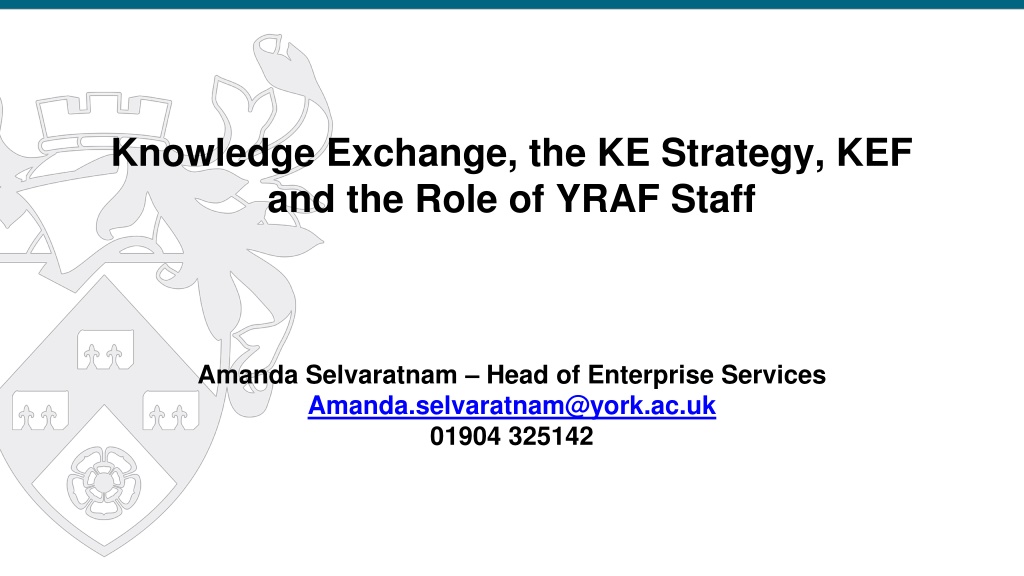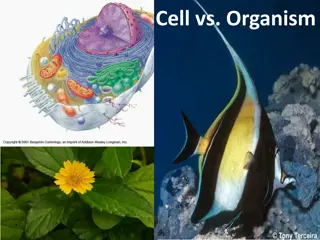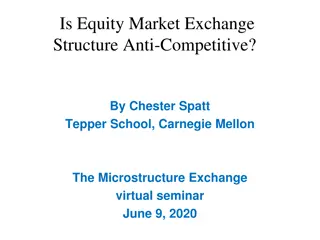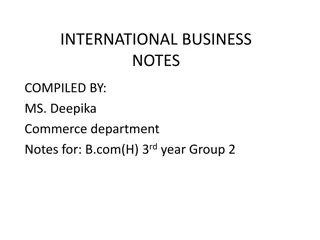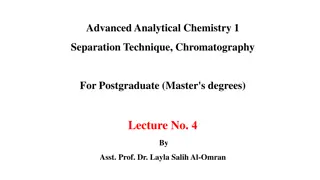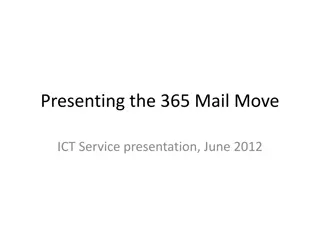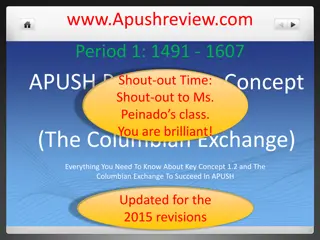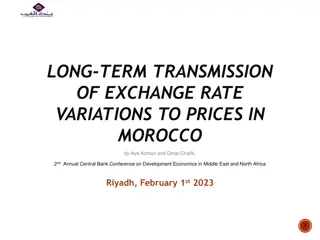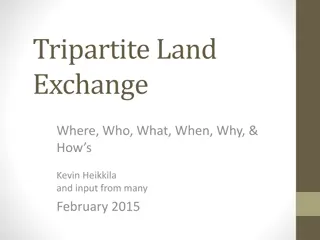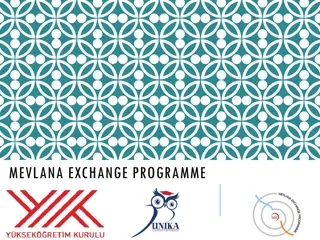Enhancing Knowledge Exchange Strategies for University Growth
Knowledge Exchange Framework (KEF) and strategies are essential for universities to improve performance, engage with stakeholders, and enhance public visibility. This involves developing diverse offerings, creating a supportive ecosystem, managing external relationships effectively, and embedding a culture of knowledge exchange. Metrics and narratives play a key role in measuring impact and providing contextual information. Funding support, workshops, commercialization, and other initiatives are crucial for successful knowledge exchange endeavors.
Download Presentation

Please find below an Image/Link to download the presentation.
The content on the website is provided AS IS for your information and personal use only. It may not be sold, licensed, or shared on other websites without obtaining consent from the author. Download presentation by click this link. If you encounter any issues during the download, it is possible that the publisher has removed the file from their server.
E N D
Presentation Transcript
Knowledge Exchange, the KE Strategy, KEF and the Role of YRAF Staff Amanda Selvaratnam Head of Enterprise Services Amanda.selvaratnam@york.ac.uk 01904 325142
Knowledge Exchange Strategy Themes 1. Offering: Develop a diverse Knowledge Exchange offering that is well articulated, proactive and informed by external stakeholder needs. 2. Support: Create an ecosystem that offers an agile and accessible support service and enables effective interaction and information sharing between staff, students and external partners 3. Communication: Manage external relationships effectively, creating mutually-beneficial opportunities through long-term partnerships encompassing multiple areas of engagement. 4. Culture: Embed Knowledge Exchange as part of everyday life at the University to enable a wide variety of impacts, ensuring it is appropriately rewarded and celebrated. Outcomes Improved HEBCIS performance. Increase in staff and students engaging in enterprise activity. High value sustainable partnerships. Improved student opportunities with employers. High quality KEF return. Increased income from industry.
The KEF - why More accessible information and data for institutions to understand and improve their own performance. More information for businesses and other users of university knowledge and resources Increased public visibility and accountability for 250m of funding
Metrics and Narrative Metrics The majority using income measures as a proxy for impact. Some non-monetised measures such as co-authorship with non-academic partners and academic time spent delivering activities. Mostly drawn from the Higher Education Business & Community Interaction (HE-BCI) survey the longest running longitudinal dataset on KE in the world: https://re.ukri.org/knowledge-exchange/the-he-bci-survey/ Narrative Used in community and public engagement and local growth and regeneration sections As a marker we need to do better here To provide useful contextual information To allow comparison between universities
How Can You Help (or how can we help you) Funding support for KE HEIF funding, Impact Accelerators etc raise awareness with the academic community, assigning work orders and ensuring costs are placed in correct work order, contacting relevant team when significant changes in spend profiles are reports Commercialisation and IP inc. spin outs Contact the Business Development Team asap business@york.ac.uk Workshops or seminars contact CPD, need dedicated cost centres for each programme cpd@york.ac.uk KTPs process any paperwork as quickly as possible Ktps@york.ac.uk Apprenticeships contact apprenticeships@york.ac.uk
How Can You Help (or how can we help you) (2) KEF most of the data is tracked but we need to development effective ways of monitoring public engagement activities ideas welcomed Training and Support the teams can provide IAG and in some cases specific training Reporting for HESA and HEBCIS Support the various teams if they come for data We will make sure you know what data to record Any other questions or ideas please get in touch Amanda Selvaratnam amanda.selvaratnam@york.ac.uk 01904 325142
Statistical clustering Scale of knowledge generation by domain Scale of knowledge generation by domain Scale of knowledge generation activity in different knowledge domains Recurrent research income (QR) Research grants and contracts income by STEM, SSB, AH Research quality by STEM, SSB, AH (number of academic FTEs getting 4* publications in REF2014) Research orientation: Research grants and contracts from different sources: UK research councils Charities Government bodies / local authorities, health/hospital authorities Industry International linkages in research: Research grants from overseas Scale & focus of knowledge activity by domain Number of academics by function Teaching/research Teaching only, Research only Proportion of academics by 12-split discipline Clinical medicine Allied health other medical, and dentistry Agriculture, forestry and veterinary science Physical sciences and mathematics Biological sciences Engineering and materials science Computer science Architecture and planning Social sciences and law Business and management studies Humanities, languages and education Creative and performing arts, and design Educational function of HEIs: Student FTEs at undergraduate level (full-time/part-time) Student FTEs involved in taught postgraduate (full-time/part-time) Student FTEs involved in research postgraduate (full-time/part-time) Intensity of knowledge generation by domain Research-focus of HEI Proportion of academic FTEs submitting to REF Proportion of students undertaking postgraduate research Research intensity by discipline Research grants and contracts income per academic by STEM, SSB, AH Proportion of researchers generating 4* publications in REF2014 by STEM, SSB, AH Research orientation intensity Research grants and contracts income from different sources (RCs, charities, gov t, industry) per academic Research internationalisation intensity Research grants and contracts income from overseas per academic Physical assets Physical assets Scale of spending on research-related capital infrastructure Intensity of capital spending (spend per academic)
